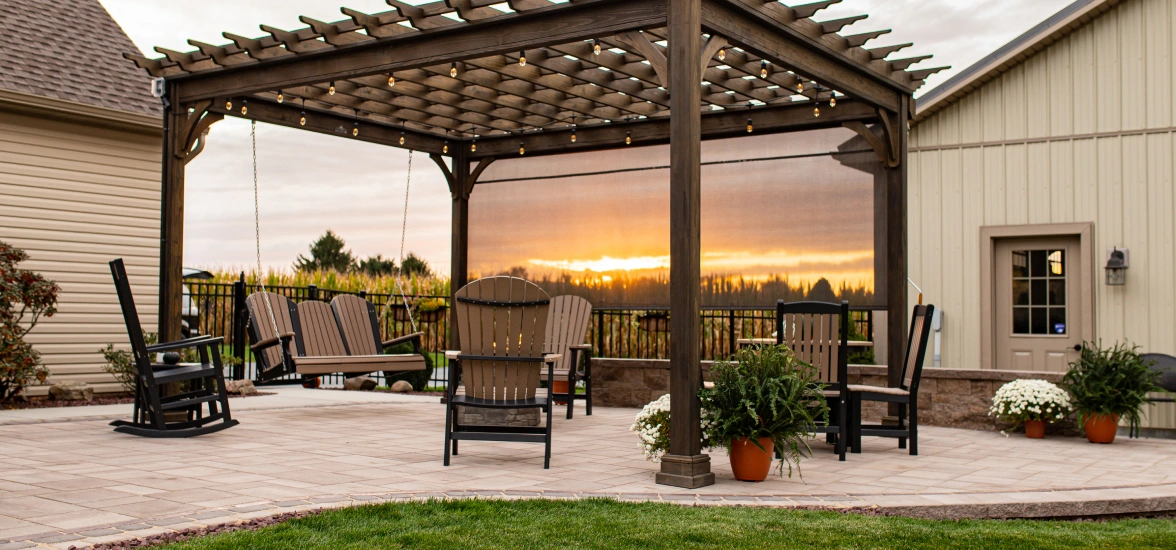With proper planning and a comprehensive Koi pond installation guide, you can find below, you can build it from scratch.
In addition, you’ll create a serene area to spend quality time and cope with everyday stress. In addition, the Koi pond is believed to bring good luck and prosperity!
How to build a Koi pond in your backyard – follow the step-by-step guide for a simple, hassle-free process.
Planning Your Koi Pond
To build your own Koi pond, you’ll have to plan the entire process, starting from location assessment through Koi pond appearance and learning about necessary local permits.
Location Selection
With a backyard Koi pond, location is just as important as the maintenance and installation. If you pick the location completely in shade or sun, your aquatic living world will suffer.
So, find a location with partial sunlight and partial shade. If possible, choose a location away from overhanging trees to reduce debris and simplify maintenance.
Design and Size
Next in your Koi pond installation process is determining the size. Keep in mind that the larger the Koi pond, the more advanced building skills it requires and the more money it costs.
The optimal size and depth for a Koi pond at home is a minimum of 1,000 gallons of water capacity and 3 feet deep.
Before you start, use a garden hose or a similar long rope to lay out the pond shape on the ground.
But, consider future Koi pond expansion and make sure to:
- Leave enough space for expansion
- Allow additional filtration system
- Allocate enough space for waterfalls, fountains, and other water structures.
- Research solar power options for pond pumps and lighting structures
Permits and Regulations
If you hire professional Koi pond builders they can advise you on local regulations regarding building codes and permits related to Koi ponds. When you do everything on your own, you’ll have to research to prevent costly fines.
You’ll have to prepare a detailed Koi pond plan with the size and features listed as part of the permit-obtaining process.
You’ll also have to adhere to the environmental standards required for such structures in your area.
Schedule inspection if necessary, and adjust the structure according to authorities’ feedback.
Materials and Tools Needed
Koi pond construction is complex because you have to ensure excavation, durable liner, and install an efficient filtration system. The building process depends on your skills, but also the quality of the materials and required tools.
Materials
To build a Koi pond properly, here are the materials to prepare.
- Pond liner (EPDM or PVC) – PVC is more affordable, but the lifespan is ten years shorter than EPDM (Ethylene Propylene Diene Monomer), EPDM is easier to maintain and install
- Underlayment – extends liner’s lifespan, and protects it from punctures.
- Pump and filtration system – choose carefully for your desired pond size
- Skimmer and bottom drain – panache water filtration and reduce maintenance
- Rocks and gravel – decorative purpose, but also a shelter for Koi fish, improves water quality and helps with the installation of aquatic plants.
- Aquatic plants
- Pond water treatment products – enhance water quality by reducing algae and improving pH level
Tools
Here is the list of tools you’ll find handy during Koi pond set up.
- Shovel and digging tools
- Level
- Utility knife
- Wheelbarrow
- Measuring tape
In addition, you can also print out this guide and keep it nearby to follow the steps precisely for a more streamlined and efficient Koi pond building process.
Step-by-Step Construction Process
When you break the construction process into several stages, you will ensure that no step is missed and everything should work as required.
Marking and Excavation
You can use spray paint on the ground or a rope to get the desired shape and mark the pond outline. Next, get a shovel and start digging!
Professional contractors use excavators or backhoes to speed up the process, which is especially important for larger ponds.
When digging the hole, create plant shelves around the perimeter of the pond. Make sure to have shelves on different levels.
Do the same for the fish, but provide:
- Gradual slopes to access deeper areas
- Deep zones regulate water temperature and protect Koi fish from predators
Installing the Underlayment and Liner
Once you have your hole ready, place the underlayment to protect the liner, by following the tips:
- Ensure the surface is clean from rocks, sharp objects, and debris
- Lay the underlayment smoothly and evenly
- Don’t make gaps, and allow overlapping of 1 feet
- Secure the edges with rocks temporarily to keep them in place
- Inspect thoroughly for gaps, wrinkles, and punctures
- Trim the excess for a tidy look
Setting Up the Filtration System
Installing an adequate filtration system is essential for maintaining high water quality and the health of your fish and plants:
- Install the skimmer on the pond edge to prevent the surface debris from clogging up the filter.
- Find the deepest point in the pond and install a bottom drain
- The filtration system should be installed on an accessible and stable surface after the skimmer and bottom drain, and away from sunlight
- Pick a pump based on your pond size and connect it with your filtration system – mechanical or biological
Adding Rocks and Gravel
Add gravel to the bottom of your bond to provide an environment for beneficial bacteria. It will also add a natural look.
Gather your rocks and spread them on the pond edges and shelves. Pick larger rocks on the edges, to mimic natural boundaries. Large rocks are also great hiding spots for Koi.
Make sure to cover all shelves on different depth levels, to ensure all small and large aquatic organisms have habitat.
A few cautious considerations for rocks:
- Make sure they are securely placed to avoid falls
- Pick ones with smooth edges to prevent fish injuries
- Clean rocks regularly to avoid build-up
Filling the Pond with Water
Filling the pond with water can be done in several steps:
- Start filling the pond slowly
- Gradually increase the water level to prevent rocks from disturbing
- Dechlorinate with water conditioner if you use tap water
- Inspect for leakage and make the necessary adjustments
Installing Aquatic Plants
Before you introduce fish to your pond, you should start developing an ecosystem with different types of plants. It will provide oxygen, create a balanced ecosystem, and filter and clean the water.
Put the plants on the shelves and around the pond edges. Create a balanced mixture of different plant types to include:
- Oxygenating plants – Anacharis, Hornwort, Waterweed
- Floating plants – Water Hyacinth, Duckweed, Water lettuce
- Marginal plants – Pickerelweed, Water Iris, Sweet flag
Prepare the plants and choose the appropriate planting method. Most plants need a submerging planting method, and marginal plants need shallow water to thrive. Monitor their growth and trim damaged foliage.
Adding Koi Fish
Your Koi fish need acclimation to water to ensure good health and transition. Take care of temperature adjustment, and ensure the container in which you hold Koi fish has the same water temperature as the pond.
Gradually, mix pond water with container water and monitor the fish’s behavior for signs of stress. After acclimation, slowly release the fish into the pond allowing them to swim freely. Additionally, make sure to:
- Release small groups of fish at a time
- Quarantine new Koi fish for several weeks in separate containers before you bring them to the pond.
- Gradually introduce a new feeding routine and monitor fish for signs of distress.
Maintaining Your Koi Pond
Learning how to build a Koi pond goes hand in hand with learning how to take care of your Koi pond.
Regular Maintenance
Regular maintenance of your Koi pond includes:
- Cleaning the filter and skimmer every week
- Testing water for quality, pH, ammonia, nitrites, and nitrates – every week or every two weeks, and after storms and heavy rains
- Monitor fish health for visible signs of distress – erratic swimming, loss of appetite, color changes, bottom-dwelling or increased surface activity clamped fins.
Seasonal Care
Seasonal care of Koi ponds focuses on preparing the Koi pond for upcoming dramatic weather changes. For example, in late fall you should install a pond heater or de-ice to prevent ice formation and keep the oxygen levels sufficient.
In the spring, thoroughly clean your Koi pond at home, restart the filter, or replace it for optimal performance. Hot temperatures in the summer may cause algae to thrive so you may need to use algae treatment.
Feeding and Caring for Koi
To ensure the good health of your Koi fish, ensure balanced nutrition.
Combine quality pellets and occasionally include healthy treats, such as fruit and veggies.
You should adjust portions based on Koi activity and never overfeed fish. Only feed your fish with what they can eat in a couple of minutes, the rest will be considered waste and compromised water quality.
Conclusion
Do you wonder how to build a small Koi pond? Building a Koi pond of any size requires careful planning and a step-by-step systematic approach to ensure that everything from layout to introducing Koi fish has been handled well.
Basic steps include – planning, digging the hole, underlayment setup, installing filtration, and adding rocks, plants, and fish. However, installing Koi fish ponds is just as important as maintaining them for fish health and a balanced aquatic ecosystem.
FAQ
Can I build a Koi pond myself, or should I hire a professional?
You can build a backyard Koi pond with a great game plan, proper tools, and a systematic approach. If you have zero experience with construction or water features, hiring professionals for Koi pond installation may be a better idea.
When should I build a Koi pond?
Mild spring and fall weather is ideal for Koi ponds buildings. That way you won’t be disrupted by extreme weather, and the fish acclimation is simpler.
What is the best size for a healthy Koi pond?
Your pond shouldn’t be smaller than 1,000 gallons of water if you want to ensure enough space for fish growth. However, if your location and resources allow, opt for at least 1,500 gallons of water for an ample fish swimming area.

